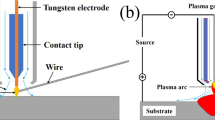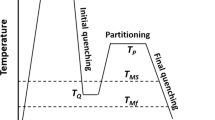Abstract
Battery cells are connected via bus-bars to meet performance requirements, such as power and capacity, and multiple layers of dissimilar materials functioning as anodes, cathodes, or bus-bars are overlapped and welded together. In laser welding, the formation of brittle intermetallic phases in the weld joint is inevitable and, in turn, deteriorates the mechanical properties. To obtain the desirable joint performance, appropriate welding parameters to avoid intermetallic phase formations and joint designs to release stress concentrations must be obtained. This study investigates the effects of lap configurations and process parameters on the tensile-shear load, T-peel load, and composition distribution when multi-layered joints of dissimilar materials are produced by laser welding. Two layers of 0.4 mm Al sheets were welded with a single 0.2 mm Cu sheet, which was emulated using electric vehicle battery interconnects. The results show that the penetration depth varied in accordance with the lap configuration even under the same heat input condition. The lap configuration and welding parameters influenced the composition distribution of the welds, as they altered the solidification rate, number of Cu/Al contact interfaces, and location of the high-density material. The failure load of the T-peel specimens was lower than that of the tensile-shear specimens except for the Cu − Al − Al lap configuration. The T-peel load of the Cu − Al − Al lap configuration was similar to that of the tensile-shear load. When the stress-concentrated joint was homogeneous, it was more robust.








Similar content being viewed by others
Data availability
No additional data available.
Code availability
Not applicable.
References
Chu S, Majumdar A (2012) Opportunities and challenges for a sustainable energy future. Nature 488(294):1–13. https://doi.org/10.1038/nature11475
Das A, Li D, Williams D, Greenwood D (2018) Joining technologies for automotive battery systems manufacturing. World Electr Veh J 9(22):1–13. https://doi.org/10.3390/wevj9020022
Lee SS, Kim TH, Hu SJ, Cai WW, Abell JA (2015) Analysis of weld formation in multilayer ultrasonic metal welding using high-speed images. J Manuf Sci Eng 137(3): 031016–1–8. https://doi.org/10.1115/1.4029787
Lee WB, Bang KS, Jung SB (2005) Effects of intermetallic compound on the electrical and mechanical properties of friction welded Cu/Al bimetallic joints during annealing. J Alloys Compd 390:212–219. https://doi.org/10.1016/j.jallcom.2004.07.057
Solchenbach T, Plapper P (2013) Mechanical characteristics of laser braze-welded aluminium–copper connections. Opt Laser Technol 54:249–256. https://doi.org/10.1016/j.optlastec.2013.06.003
Zuo D, Hu S, Shen J, Xue Z (2014) Intermediate layer characterization and fracture behavior of laser-welded copper/aluminum metal joints. Mater Des 58:357–362. https://doi.org/10.1016/j.matdes.2014.02.004
Schmalen P, Plapper P (2016) Evaluation of laser braze-welded dissimilar Al–Cu ioints. Phys Procedia 83:506–514. https://doi.org/10.1016/j.phpro.2016.08.052
Xue Z, Hu S, Zuo D, Cai W, Lee D, Elijah KA (2013) Molten pool characterization of laser lap welded copper and aluminum. J Phys D Appl Phys 46:495501-1–495509. https://doi.org/10.1088/0022-3727/46/49/495501
Schmalen P, Plapper P, Cai W (2016) Process robustness of laser braze-welded Al/Cu connectors. SAE Int J Altern Powertrains 5(1):195–204. https://doi.org/10.4271/2016-01-1198
Zhou L, Li Z, Song X, Tan C, He Z, Huang Y, Feng J (2017) Influence of laser offset on laser welding-brazing of Al/brass dissimilar alloys. J Alloys Compd 717:78–92. https://doi.org/10.1016/j.jallcom.2017.05.099
Xiong J, Peng Y, Zhang H, Li J, Zhang F (2018) Microstructure and mechanical properties of Al-Cu joints diffusion-bonded with Ni or Ag interlayer. Vacuum 147:187–193. https://doi.org/10.1016/j.vacuum.2017.10.033
Solchenbach T, Plapper P, Cai W (2014) Electrical performance of laser braze-welded aluminum–copper interconnects. J Manuf Processes 16:183–189. https://doi.org/10.1016/j.jmapro.2013.12.002
Braunovic M (2017) Reliability of power connections. J Zhejiang Univ Sci A 8(3):343–356. https://doi.org/10.1631/jzus.2007.A0343
Lee SJ, Nakamura H, Kawahito Y, Katayama S (2014) Effect of welding speed on microstructural and mechanical properties of laser lap weld joints in dissimilar Al and Cu sheets. Sci Technol Weld Joining 19(2):111–118. https://doi.org/10.1179/1362171813Y.0000000168
Kraetzsch M, Standfuss J, Klotzbach A, Kaspar J, Brenner B, Beyer E (2011) Laser beam welding with high-frequency beam oscillation: Welding of dissimilar materials with brilliant fiber lasers. Phy Procedia 12:142–149. https://doi.org/10.2351/1.5062231
Mai T, Spowage A (2004) Characterisation of dissimilar joints in laser welding of steel–kovar, copper–steel and copper–aluminium. Mater Sci Eng A 374:224–233. https://doi.org/10.1016/j.msea.2004.02.025
Tan C, Jiang Z, Li L, Chen Y, Chen X (2013) Microstructural evolution and mechanical properties of dissimilar Al–Cu joints produced by friction stir welding. Mater Des 51:466–473. https://doi.org/10.1016/j.matdes.2013.04.056
Sahin M (2010) Joining of aluminium and copper materials with friction welding. Int J Adv Manuf Technol 49:527–534. https://doi.org/10.1007/s00170-009-2443-7
Abbasi M, Taheri AK, Salehi M (2001) Growth rate of intermetallic compounds in Al/Cu bimetal produced by cold roll welding process. J Alloys Compd 319:233–241. https://doi.org/10.1016/S0925-8388(01)00872-6
Satpathy MP, Sahoo SK (2017) Mechanical performance and metallurgical characterization of ultrasonically welded dissimilar joints. J Manuf Processes 25:443–451. https://doi.org/10.1016/j.jmapro.2017.01.001
Xi L, Banu M, Hu SJ, Cai W, Abell J (2017) Performance prediction for ultrasonically welded dissimilar materials joints. J Manuf Sci Eng 139(1): 011008–1–13. https://doi.org/10.1115/1.4033692
Das A, Masters I, Williams D (2019) Process robustness and strength analysis of multi-layered dissimilar joints using ultrasonic metal welding. Int J Adv Manuf Technol 101:881–900. https://doi.org/10.1007/s00170-018-2936-3
Luo Y, Chung H, Cai W, Rinker T, Hu SJ, Kannatey-Asibu E, Abell J (2018) Joint formation in multilayered ultrasonic welding of Ni-coated Cu and the effect of preheating. J Manuf Sci Eng 140(11): 111003–1–10. https://doi.org/10.1115/1.4040878
Schmidt PA, Schmitz P, Zaeh MF (2016) Laser beam welding of electrical contacts for the application in stationary energy storage devices. J Laser Appl 28(2): 022423–1–6. https://doi.org/10.2351/1.4943908
Huang W, Wang H, Rinker T, Tan W (2020) Investigation of metal mixing in laser keyhole welding of dissimilar metals. Mater Des 195:109056-1–109114. https://doi.org/10.1016/j.matdes.2020.109056
Hummel M, Külkens M, Schöler C, Schulz W, Gillner A (2021) In situ X-ray tomography investigations on laser welding of copper with 515 and 1030 nm laser beam sources. J Manuf Processes 67:170–176. https://doi.org/10.1016/j.maapro.2021.04.063
Li Z, Yu G, He X, Li S, Li Z (2020) Fluid flow and solute dilution in laser linear butt joining of 304SS and Ni. Int J Heat Mass Transf 161:120233-1–120316. https://doi.org/10.1016/j.ijheatmasstransfer.2020.120233
Trvassoli S, Abbasi M, Tahavvori R (2016) Controlling of IMCs layers formation sequence, bond strength and electrical resistance in AlCu bimetal compound casting process. Mater Des 108:343–353. https://doi.org/10.1016/j.matdes.2016.06.076
Otten C, Reisgen U, Schmachtenberg M (2016) Electron beam welding of aluminum to copper: mechanical properties and their relation to microstructure. Weld World 60:21–31. https://doi.org/10.1007/s40194-015-0280-x
Yan S, Shi Y (2019) Influence of laser power on microstructure and mechanical property of laser-welded Al/Cu dissimilar lap joints. J Manuf Process 45:312–321. https://doi.org/10.1016/j.jmapro.2019.07.009
Acknowledgements
We acknowledge the financial and technical support provided by the Korea Institute of Industrial Technology (EO-21-090).
Author information
Authors and Affiliations
Contributions
Joonghyeon Shin contributed to conceptualization, methodology, writing. Minjung Kang helped in supervision review, data curation and editing, funding acquisition.
Corresponding author
Ethics declarations
Ethical approval
No ethical approval was required for this research.
Consent to participate
Not applicable.
Consent to publish
All authors have read and agreed to the published version of the manuscript.
Competing interests
The authors declare no competing interests.
Additional information
Publisher's Note
Springer Nature remains neutral with regard to jurisdictional claims in published maps and institutional affiliations.
Rights and permissions
About this article
Cite this article
Shin, J., Kang, M. Effects of lap configuration on mechanical properties and composition distribution of three-layer overlapped laser weldments on Al/Cu dissimilar materials. Int J Adv Manuf Technol 121, 2041–2048 (2022). https://doi.org/10.1007/s00170-022-09433-4
Received:
Accepted:
Published:
Issue Date:
DOI: https://doi.org/10.1007/s00170-022-09433-4




